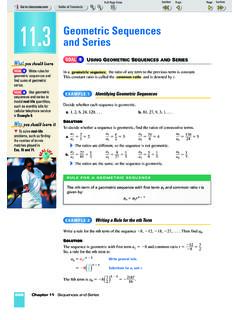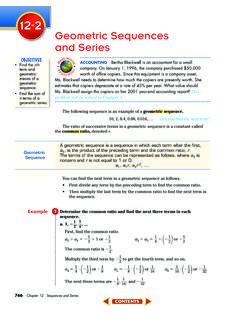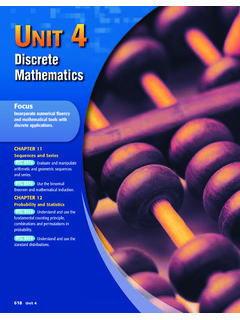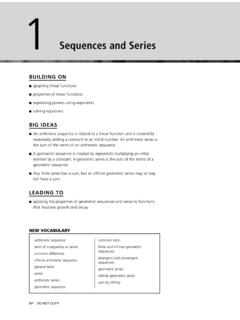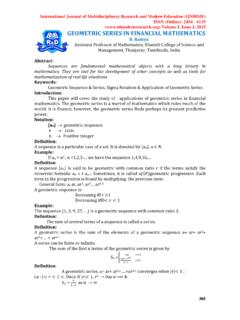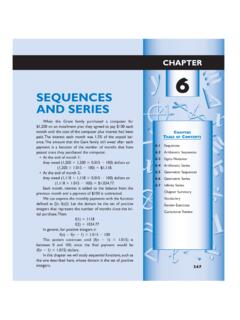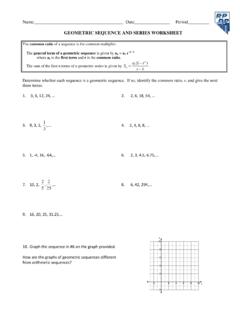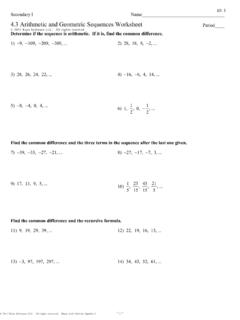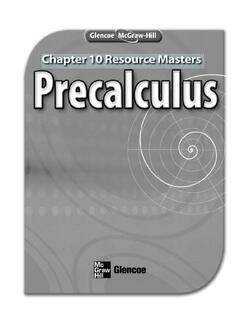Transcription of Sequence and Series Review Answer Key - Lexington
1 Math 2B/3A Name _____ANSWER KEY_____. Sequence and Series Review Sequence and Series Review Skills and Concepts: Identifying whether a Sequence or Series is arithmetic, geometric or neither Writing a function that generates a Sequence of numbers, particularly linear and exponential functions Writing function rules using both recursive and closed/explicit formats Generating a table of values from a recursive or closed/explicit function rule Finding the nth term of a Sequence (generate a rule and plug in the appropriate value). Calculating the number of terms in a Sequence (function rule = last term, solve for n). Applying Gauss' and Euclid's formulas to find sums of arithmetic and geometric Series Find definite and indefinite sums using sigma notation Identify properties of Sigma Determine the number of terms being added in a Series Identify whether a function is linear, quadratic, exponential or none of these Identify if the terms of a Sequence have a limit Determine if the sum of a Series has a limit and what that limit is Mixed Problem Set: 1.
2 State whether the Sequence is arithmetic, geometric , or neither and state a function rule that will generate the given Sequence if it is arithmetic or geometric . a. 10, 6, 2, -2, b. 3, 6, 11, 18, 27, . Arithmetic, subtract 4 Neither, adding 3, 5, 7, . 10 4(n 1) = 14 4n 1 1 1 1. c. 2, 6, 18, 54, d. , , , ,.. 2 3 4 5. 1. geometric , multiply by 3 Neither, n +1. 2( 3)n 1 = 2( 3)n/3. 2. Given an arithmetic Sequence where t2 = . 6 and t6 = 16. Find t21. 4 steps from 2 to 6 adds 10 so the difference is 10/4 = each step tn = 1 + so t21 = 1 + (21) = 3. Write a recursive rule for the Sequence , 4, 20, 100, . n =0. f (n) = . f (n 1) 5 n > 0.. Sequence and Series Review Answer Key page 2. 4. Find the sum of the first six terms of the Sequence : 27, 9, 3, 1, . 1 6 . 27 1 . 3 . geometric with r = 1/3 and a first term of 27 so sum = = 1.
3 1 . 3 . 5. Evaluate: 6 20. a. 3k(k + 2) b. (3n 1). k =1 n =0. 21( 1+ 59). Neither arithmetic nor geometric Arithmetic, = 609. 2. so you have to calculate and add . the terms sum = 399.. 12 15. c. ( 2)k d. 6. k =1 i=4. geometric , (. 2 1 ( 2). 12. ) = 2730 Neither, but sum = 6(# of terms) = 72. 1 ( 2) .. n n e. f. ( 4 j 3). k =0 j =1. (. 1 1 (.6). n +1. ) = 5 1 (.6) n( 7 4n 3). geometric , 1 (.6) 2. ( )n +1. Arithmetic, 2. = n(5 + 2n).. 6. Explain in words what the word limit means in mathematics. Where the function goes, a specific number that the function gets closer and closer to. Sequence and Series Review Answer Key page 3. 7. Determine if the following Series has a limit. Explain how you know. If it does, find the limit. 1 1 1 1 1 1 1. a. 1+ + + +.. b. ! + ! +.
4 3 9 27 2 4 8 16. geometric with r < 1, sum limit = geometric with r < 0, sum limit = 1/3. c. 1+ 3+ 9 + 27 +.. d. 1+ + + +.. geometric with r > 1, no limit for the sum geometric with r < 0, sum limit = For each of the following rules: A. find the first 4 terms of the Sequence , starting at term 0. B. determine the type of Sequence (arithmetic, geometric , neither). C. write the sum of the finite Series from k = 0 to 100 in sigma notation D. for any arithmetic or geometric Series , find the sum written in part C. 8. tn = 5 + 3n Arithmetic, adding 3 9. tn = n2 1 Neither 100 100. 5 + 3n = 5 + 8 +11+14 + ..+ 305 = 15655 n 2. 1 = 1+ 0 + 3 + 8 + ..+ 9999. n =0 n =0.. 1 n 10. tn= 2 geometric , r = 11. tn = 8( ) n geometric , r = 4 . 100. 1 n 1 1 1 100. 4 = 2 + 2 + 8 + 32 +.
5 = 2 23. 2 8( ) = 8 4 + 2 1+ .. = 5 3. n 1. n =0 n =0.. Sequence and Series Review Answer Key page 4. For each table, determine a function rule that fits the values in the table. Write a recursive and explicit rule for each table. Then, find the sum of the first 20 terms of each Sequence . 12. n f(n) . 13. n f(n) r 0 3 4 1 1 2. 1 7 4 2 2 2. 2 11 4 3 4 2. 3 15 4 8. Closed: f(n) = 4n + 3 Closed: f(n) = 2n * or 1 * 2n-1. 3 n =0 1 n =1. Recursive: f (n) = Recursive: f (n) = . f (n 1) + 4 n >0 f (n 1) 2 n > 1.. 14. Find the number of terms in each Sequence . a. 2, 5, 8, , 149 b. 178, 170, 168, , 2. Arithmetic, adding 3 Arithmetic, adding 2. f(n) = 3n 1 = 149 so n = 50 f(n) = 2n + 180 = 2 so n = 89. 15. Each statement below is false. Correct the statement so that it is true.
6 15 15 15 n a. 32k = k + 32 b. 3 = 3n k =8 k =8 k =8 i=0. 15 n n Should be 32 k Should be 3 = 3(n +1) or 3 = 3n k =8 i=0 i=1.. Sequence and Series Review Answer Key page 5. 16. Suppose a doctor earns $80,000 in the first year of practice. Suppose also that each succeeding year the doctor's salary increases 10%. What is the total of the doctor's salary over the first 10 years in practice? To increase by 10% each year, multiply by this makes it a geometric Series . Using 80,000(1 ). Euclid's method to solve: = $1,274, 1 17. A Value Appliance store has radios that can be purchased on a daily installment plan. For a particular type of radio you pay only 1 cent the first day, 2 cents the second day, 4 cents the The day you get to take the radio home you paid 8,192 cents.
7 How long third day and so on. did it take you to pay for the radio? How much did you pay for the radio? n 1+ 2 + 4 + 8 + ..+ 8192 = 12 (2) n but we need to find out what n is. 8192 = 1. 2 2n k =1. It is a little easier to multiply both sides by 2 to work with the equation 16384 = 2n and then to solve by trial an error to find that n = 14. It took 14 days (two weeks) to pay for the radio. 1(1 214 ) . Using Euclid's method to find the total paid: = 16384 cents = $ 1 2. 18. What is Gauss' Formula? Try to write it without looking at your notes. If you write it with variables only, what does each variable represent? . n(t + t ). sum = 1 n where n is the number of terms, t1 = the first term and tn = the last term 2. 19. What is Euclid's Formula? Try to write it without looking at your notes.
8 What does each variable in the formula represent? . t1 (1 r n ). sum = where n is the number of terms, t1 = the first term, r is the ratio between 1 r terms (what you multiply each term by to get the next term). n 20. Write a closed expression for the sum given by: 2i 6 and find the sums of the first 10. i=1. terms, the first 100 terms and the first 1000 terms. n n( 4 + 2n 6) n(2n 10). 2i 6 = 4 2 + 0 + 2 + 4 + ..+ 2n 6 = 2. =. 2. = n(n 5). i=1. 10 100 1000. 2i 6 = 50 2i 6 = 9500 2i 6 = 995000. i=1 i=1 i=1.. Sequence and Series Review Answer Key page 6. 21. A snow day phone chain is set up to let people know if there is no school. The principal calls the 4 deans. Each of the deans calls 4 teachers. Each of the teachers calls 4 more teachers. This continues until the entire faculty and staff knows about the snow day.
9 If there are 6. rounds of telephone calls, how many people are on staff at the school? Is this a reasonable number of staff members for our school? 6. 4(1 4 6 ). If we include the principal at the end, 4 i = 4 +16 + 64 + .. = 1 4. = 5460. i=1. So, with the principal, there are 5461 faculty and staff members. This is more than the number of students in the school not a reasonable number.. 22. You have saved money well and have $2153 in your savings account. Now that you have your driver's license, your parents make you get gas for the car every week. You spend $18. a week on gas. Write a function that models your dwindling savings. How many weeks can you buy gas before you run out of money? Let n be the number of weeks you are paying for gas, then the calculation to solve for n is $2153 - $18(n) = 0.
10 This gives n = so after 119 weeks you don't have enough left to pay for the gas. 23. What kind of function models an arithmetic Sequence ? Linear 24. What kind of function models a geometric Sequence ? Exponential Example for #26. 25. How do you know if a function is linear? n f(n) 2. Adding the same amount each time is the same as having the same slope from point to point so a function is linear if the 0 4 3 6. Sequence of points is arithmetic. Otherwise, it is a polynomial of degree 1. 1 7 9 6. 26. How do you know if a function is quadratic? The second level of differences is the same. See the example in 2 16 15 6. the table at the right. Otherwise, it is a polynomial of degree 2. 3 31 21. 27. How do you know if a function is exponential? The terms are multiplied by the same amount each time.
